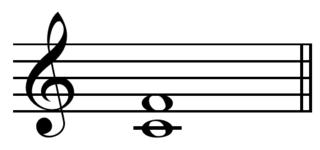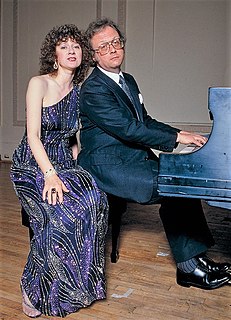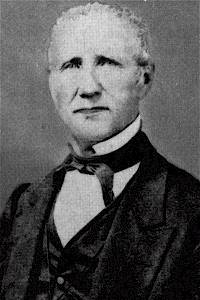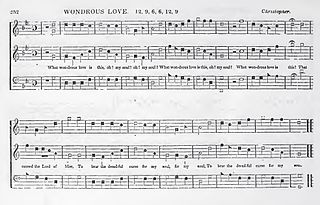Related Research Articles

Polyphony is a type of musical texture consisting of two or more simultaneous lines of independent melody, as opposed to a musical texture with just one voice, monophony, or a texture with one dominant melodic voice accompanied by chords, homophony.

A fourth is a musical interval encompassing four staff positions in the music notation of Western culture, and a perfect fourth is the fourth spanning five semitones. For example, the ascending interval from C to the next F is a perfect fourth, because the note F is the fifth semitone above C, and there are four staff positions between C and F. Diminished and augmented fourths span the same number of staff positions, but consist of a different number of semitones.

Southern rock is a subgenre of rock music and a genre of Americana. It developed in the Southern United States from rock and roll, country music, and blues and is focused generally on electric guitars and vocals. Author Scott B. Bomar speculates the term "southern rock" may have been coined in 1972 by Mo Slotin, writing for Atlanta's underground paper, The Great Speckled Bird, in a review of an Allman Brothers Band concert.

Shape notes are a musical notation designed to facilitate congregational and social singing. The notation, introduced in late 18th century England, became a popular teaching device in American singing schools. Shapes were added to the noteheads in written music to help singers find pitches within major and minor scales without the use of more complex information found in key signatures on the staff.

A hymnal or hymnary is a collection of hymns, usually in the form of a book, called a hymnbook. Hymnals are used in congregational singing. A hymnal may contain only hymn texts ; written melodies are extra, and more recently harmony parts have also been provided.

William Billings is regarded as the first American choral composer, and leading member of the First New England School.
William Duckworth was an American composer, author, educator, and Internet pioneer. He wrote more than 200 pieces of music and is credited with the composition of the first postminimal piece of music, The Time Curve Preludes (1977–78), for piano. Duckworth was a Professor of Music at Bucknell University. Together with Nora Farrell, his wife, he ran Monroe Street Music, the publisher of many Duckworth's pieces.

William Elden Bolcom is an American composer and pianist. He has received the Pulitzer Prize, the National Medal of Arts, a Grammy Award, the Detroit Music Award and was named 2007 Composer of the Year by Musical America. He taught composition at the University of Michigan from 1973 until 2008. He is married to mezzo-soprano Joan Morris.

In music from Western culture, a sixth is a musical interval encompassing six note letter names or staff positions, and the major sixth is one of two commonly occurring sixths. It is qualified as major because it is the larger of the two. The major sixth spans nine semitones. Its smaller counterpart, the minor sixth, spans eight semitones. For example, the interval from C up to the nearest A is a major sixth. It is a sixth because it encompasses six note letter names and six staff positions. It is a major sixth, not a minor sixth, because the note A lies nine semitones above C. Diminished and augmented sixths span the same number of note letter names and staff positions, but consist of a different number of semitones.
The intervals from the tonic (keynote) in an upward direction to the second, to the third, to the sixth, and to the seventh scale degrees (of a major scale are called major.

The Southern Harmony, and Musical Companion is a shape note hymn and tune book compiled by William Walker, first published in 1835. The book is notable for having originated or popularized several hymn tunes found in modern hymnals and shape note collections like The Sacred Harp.

William Walker was an American Baptist song leader, shape note "singing master", and compiler of four shape note tunebooks, most notable of which are the influential The Southern Harmony and The Christian Harmony, which has been in continuous use.
Syrianus was a Greek Neoplatonist philosopher, and head of Plato's Academy in Athens, succeeding his teacher Plutarch of Athens in 431/432. He is important as the teacher of Proclus, and, like Plutarch and Proclus, as a commentator on Plato and Aristotle. His best-known extant work is a commentary on the Metaphysics of Aristotle. He is said to have written also on the De Caelo and the De Interpretatione of Aristotle and on Plato's Timaeus.
Lovely Music is an American record label devoted to new American music. Based in New York City, the label was founded in 1978 by Mimi Johnson, an outgrowth of her nonprofit production company Performing Artservices Inc. It is one of the most important and longest running labels focusing exclusively on new music and has released over 100 recordings on LP, CD, and videocassette.

Bill Tarmey was an English actor and singer, best known for playing Jack Duckworth in the soap opera Coronation Street. First appearing in the role in November 1979, he played it continually from 1981 to 2010.

Émile Louis Fortuné Pessard was a French composer.

Mosco Carner was an Austrian-born British musicologist, conductor and critic. He wrote on a wide range of music subjects, but was particularly known for his studies on the life and works of the composers Giacomo Puccini and Alban Berg.

In music, the third factor of a chord is the note or pitch two scale degrees above the root or tonal center. When the third is the bass note, or lowest note, of the expressed triad, the chord is in first inversion.

"What Wondrous Love Is This" is a Christian folk hymn from the American South. Its text was first published in 1811, during the Second Great Awakening, and its melody derived from a popular English ballad. Today it is a widely known hymn included in hymnals of many Christian denominations.
The Time Curve Preludes is a minimalist composition for piano solo by William Duckworth written between 1977 and 1978. This piece is credited as the first postminimal piece of music, and is his most frequently heard work. The Time Curve Preludes were composed between 1977 and 1978 on a fellowship from the National Endowment for the Arts. They were premiered at Wesleyan University in 1979 by pianist Neely Bruce. Duckworth used elements of Minimalism, including repetition and accessible harmonies, yet also embraced more quickly changing structures; wide-ranging, complex melodies; and colorful dissonances.